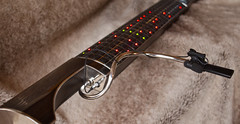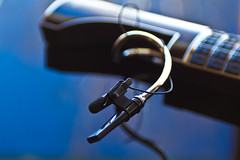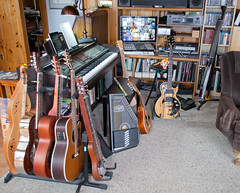Yet another shot of the alpha with the mic on the breathpipe
Friday, December 31, 2010
Friday, December 24, 2010
Eigenharp Alpha with DPA Microphone
The DPA Microphone is a great addition to the Alpha. It plugs in just beside the breathpipe and includes a mount on a new breath pipe mouthpiece which the mic can clip to.
It is an electret mic for which the Alpha provides the polarizing voltage (the voltage levels can be selected either by belcanto or by the control keys as can the various controls such as vol, pan, effect send, etc)
It is an electret mic for which the Alpha provides the polarizing voltage (the voltage levels can be selected either by belcanto or by the control keys as can the various controls such as vol, pan, effect send, etc)
Friday, November 26, 2010
Winter Studio
The Alpha and Pico with all their friends.
Click on the picture to see this in Flickr with notes!
Click on the picture to see this in Flickr with notes!
Saturday, August 14, 2010
Canadian Distributor
There is now a distributor in Ottawa, Canada
http://www.crystal-harp.com/default.aspx
http://www.crystal-harp.com/default.aspx
Tuesday, August 3, 2010
Root Lights Chromatic
NEOLOGIC (http://twitter.com/neologicjapan) shared some belcanto to light up the root notes on split 1, Alpha factory 3, set to chromatic. It can be found here: NEOLOGIC Blog.
This can be turned into a script for easy use. See the details on scripts at the Eigenlabs WIKI here: http://eigenlabs.com/wiki/Belcanto_Scripts/.
And here it is as a script (you can cut and past this into textedit and store / use it as described at the link above)
description
Script by NEOLOGIC to light led root notes on keygroup1, chromatic scale
script
gain create
it to light gain name ify
talker create
it to light talker name ify
kgroup 1 output 41 to light talker connect
kgroup 1 output 42 to light talker connect
kgroup 1 output 63 to light talker connect
kgroup 1 output 64 to light talker connect
kgroup 1 output 65 to light talker connect
kgroup 1 output 85 to light talker connect
kgroup 1 output 86 to light talker connect
kgroup 1 output 87 to light talker connect
kgroup 1 output 88 to light talker connect
kgroup 1 output 107 to light talker connect
kgroup 1 output 108 to light talker connect
kgroup 1 output 109 to light talker connect
kgroup 1 output 110 to light talker connect
light talker listen
light gain listen
volume to 0 when 13 set
volume to 0 when 31 set
volume to 0 when 43 set
volume to 0 when 49 set
volume to 0 when 61 set
volume to 0 when 79 set
volume to 0 when 97 set
volume to 0 when 115 set
This can be turned into a script for easy use. See the details on scripts at the Eigenlabs WIKI here: http://eigenlabs.com/wiki/Belcanto_Scripts/.
And here it is as a script (you can cut and past this into textedit and store / use it as described at the link above)
description
Script by NEOLOGIC to light led root notes on keygroup1, chromatic scale
script
gain create
it to light gain name ify
talker create
it to light talker name ify
kgroup 1 output 41 to light talker connect
kgroup 1 output 42 to light talker connect
kgroup 1 output 63 to light talker connect
kgroup 1 output 64 to light talker connect
kgroup 1 output 65 to light talker connect
kgroup 1 output 85 to light talker connect
kgroup 1 output 86 to light talker connect
kgroup 1 output 87 to light talker connect
kgroup 1 output 88 to light talker connect
kgroup 1 output 107 to light talker connect
kgroup 1 output 108 to light talker connect
kgroup 1 output 109 to light talker connect
kgroup 1 output 110 to light talker connect
light talker listen
light gain listen
volume to 0 when 13 set
volume to 0 when 31 set
volume to 0 when 43 set
volume to 0 when 49 set
volume to 0 when 61 set
volume to 0 when 79 set
volume to 0 when 97 set
volume to 0 when 115 set
Thursday, July 29, 2010
Sampling rate hint
I noticed that the cello model was aliasing at higher pitches (hey, it IS a cello, and this is above its proper range). Anyway, increasing the sampling rate to 96K helped substantially.
Sunday, July 18, 2010
Tritone Substitution
So, here is a tritone substitution showing C7 to F#7. These chords share two notes.
You may want to read this: Wikipedia, Tritone Substitution
The fingering charts shown here work for improvisation between these two chords.
One could also start the F# chord at 7 (ie in the centre course) and the C chord at '5 to get more even a spread of notes around both roots. In fact, that would probably be a better approach.
I've probably missed a few of the blue notes as well but you get the idea. Corrections or additions are welcome
You may want to read this: Wikipedia, Tritone Substitution
The fingering charts shown here work for improvisation between these two chords.
One could also start the F# chord at 7 (ie in the centre course) and the C chord at '5 to get more even a spread of notes around both roots. In fact, that would probably be a better approach.
I've probably missed a few of the blue notes as well but you get the idea. Corrections or additions are welcome
Alpha Chromatic Chord Shapes
 Here are a couple of chord shapes for an Alpha set to chromatic. Click the diagram for a bigger view.
Here are a couple of chord shapes for an Alpha set to chromatic. Click the diagram for a bigger view.The numbers relate to the keys on the alpha with 1 being C in the centre course counting up towards the spike and down towards the headstock. 'N moves one course towards the breath pipe, N' one away, etc.
Note that the shapes are exactly the same.
Another Approach...
... might be based on this http://numberednotes.com/
One could consider numbering Alpha keys from 1, starting from the C in the middle course (chromatic) with 'prime' markings for different courses
So:
C would be 1 ,
E would be 1' , (or 5 if played in the center course)
g# above would be 1'' (or 5' )
while g# below would be '1 (or -4 if played in the center course)
A numbering system like this could be overlaid on the either a chromatic staff (described in an earlier post) to better suggest fingering or it could be overlaid on a standard staff.
Exactly the same numbering system could be used in different scales (since it is key not tone oriented) for music that does not include notes outside of the scale used. While this does not work on the chromatic scale I've been toying with, it would work on standard notation.
This would certainly be an advantage to anyone approaching a new song. One could also consider adding chord diagrams much like guitar above the staff to suggest a 'home' position for the phrase in question.
One could consider numbering Alpha keys from 1, starting from the C in the middle course (chromatic) with 'prime' markings for different courses
So:
C would be 1 ,
E would be 1' , (or 5 if played in the center course)
g# above would be 1'' (or 5' )
while g# below would be '1 (or -4 if played in the center course)
A numbering system like this could be overlaid on the either a chromatic staff (described in an earlier post) to better suggest fingering or it could be overlaid on a standard staff.
Exactly the same numbering system could be used in different scales (since it is key not tone oriented) for music that does not include notes outside of the scale used. While this does not work on the chromatic scale I've been toying with, it would work on standard notation.
This would certainly be an advantage to anyone approaching a new song. One could also consider adding chord diagrams much like guitar above the staff to suggest a 'home' position for the phrase in question.
A Possible Eigenharp Chromatic Staff
I do not know if this will be useful yet, but here is one possible staff.
Setting up the keygroup so that C is in the middle course, the white area covers all five courses.
While this is true, likely fingerings are not obvious from just this representation. For example B below middle C as shown would suggest the key one course down and 3 keys up (down?) but might more often be played just one key down (up?).
At some point, I think I'll try placing useful chords on this notation with possible fingering shown tab-style as a test.
If you are interested, have a look here: http://musicnotation.org/
Setting up the keygroup so that C is in the middle course, the white area covers all five courses.
While this is true, likely fingerings are not obvious from just this representation. For example B below middle C as shown would suggest the key one course down and 3 keys up (down?) but might more often be played just one key down (up?).
At some point, I think I'll try placing useful chords on this notation with possible fingering shown tab-style as a test.
If you are interested, have a look here: http://musicnotation.org/
Alpha Tab / Notation?
One can, of course, use existing notation. However, I find myself working more like a guitar player starting from chord progressions and using an appropriate scale.
That said, I've been giving some thought to what notation might be more appropriate to the Alpha, particularly in a chromatic scale.
Perhaps the Alpha is better suited to an intervalic form of notation such as this one: A Chromatic Staff. In other words, use a staff that simply lays out a single course of keys and relying on the player to 'fold' up a course every 5th? This would, at least, recognize that the Alpha does not have a piano-like layout. (If you think about it, the standard staff models a piano quite well with sharps and flats telling you to use the black keys).
It might also be possible to code in the course as a number (like guitar TAB) although this either puts some constraints on the keygroup setup or relies on the player to do a translation. (If one ignores the number, it looks just like the chromatic staff above, so there is nothing lost by adding course use suggestions that might be 'wrong' for a particular keygroup or improved on by a particular player)
I'll have to translate some song into such a notation as an experiment. Unless some king soul knows of some software that will do this??
Here is a link to triads notated in several ways. It strikes me that most of the chromatic staffs would be better suited to the Eigenharps. Triad Comparisons
Saturday, June 26, 2010
A Tale of Two Stands
Well, I changed stands for my Eigenharp after seeing the one Tenebrous is using.
Here they are side by side.
The one on the right is the one made by K&M that Eigenlabs provides as an option. It is very sturdy and, as a result, quite heavy. The upper support is large and has a flat surface that is as wide as the back of the instrument (a good thing). However, if it is at the wrong angle, it is possible to have the metal touch the instrument.
The one on the left is by Hercules and it is much lighter (and less robust), the upper support is more rounded (but completely covered in padding).
For me, the deciding factors were that the hercules stand folds up *much* smaller, it (optionally) comes with a carrying bag, and it fits into smaller spaces because the legs are lower when unfolded.
Buying advice: If you want the best stand for a fixed location, the K&M stand is probably the stand for you. For going out to gigs, or in small spaces, the Hercules stand is great.
Oh, BTW, here is Tene's which is entirely black. And, wait a minute, what it that round thing you also need?...
Here they are side by side.
The one on the right is the one made by K&M that Eigenlabs provides as an option. It is very sturdy and, as a result, quite heavy. The upper support is large and has a flat surface that is as wide as the back of the instrument (a good thing). However, if it is at the wrong angle, it is possible to have the metal touch the instrument.
The one on the left is by Hercules and it is much lighter (and less robust), the upper support is more rounded (but completely covered in padding).
For me, the deciding factors were that the hercules stand folds up *much* smaller, it (optionally) comes with a carrying bag, and it fits into smaller spaces because the legs are lower when unfolded.
Buying advice: If you want the best stand for a fixed location, the K&M stand is probably the stand for you. For going out to gigs, or in small spaces, the Hercules stand is great.
Oh, BTW, here is Tene's which is entirely black. And, wait a minute, what it that round thing you also need?...
Alpha Chromatic
Here is the Split 1 from the factory Alpha setup set to a C chromatic keyboard.
Notes that are the same colour are in the same octave (and many are duplicated / unison notes). It is worth noting that unison notes can be pitched and yawed separately for some interesting effects. The white spaces are the sharps or flats.
The good news is that you have all the accidentals. The bad news is that you have a less range than with non-chromatic scales and different patterns for chords.
If you find this might be useful, click on the image for a full sized one which you can save and print for your own use.
Only the playable keys are shown (ie: the two bottom rows are missing). and, oops, I see that I did not fill in the bottom row. So that is left to the reader as an exercise. (I had a math professor who once said that meant the author could not do it. In this case the author is too Lazy)
Notes that are the same colour are in the same octave (and many are duplicated / unison notes). It is worth noting that unison notes can be pitched and yawed separately for some interesting effects. The white spaces are the sharps or flats.
The good news is that you have all the accidentals. The bad news is that you have a less range than with non-chromatic scales and different patterns for chords.
If you find this might be useful, click on the image for a full sized one which you can save and print for your own use.
Only the playable keys are shown (ie: the two bottom rows are missing). and, oops, I see that I did not fill in the bottom row. So that is left to the reader as an exercise. (I had a math professor who once said that meant the author could not do it. In this case the author is too Lazy)
Alpha CMaj Keyboard
This is the arrangement of notes on an Eigenharp Alpha split 1 set to a CMaj scale. Notes that are coloured the same are in the same octave (so, for example, all the light blue Cs are the same note).
Of course, If you want to transpose your playing in a (major) key, you can simply change the root note and use all the same fingering.
The triangles on the left correspond to the divots in at the rear of the alpha and can be used as aids in locating your fingers.
For playing, I tend to start with the 1st purple C in the center course as 'middle' C. as that gives a lot of 'space' on both sides.
A quick look shows that all sorts of interesting chords are easy to make.
Friday, June 11, 2010
Introductory Post
Like many people, I was quite taken by the early videos of the eigenharps. There was a post on a mailing list for wind players that first sent me looking.
At that time they did not ship to Canada so I kept pestering them and eventually it was possible to order a pico.
The pico is a great starting point if anyone is interested. It is relatively inexpensive and yet has almost all the same software capabilities (it lacks an arrange function to this point).
It is quite small but in many ways this is its big advantage. Compared to a WX5/7 it actually has more keyboard and support for scales extends this further.
Anyway, I was sold and moved up to the alpha shown above.
At that time they did not ship to Canada so I kept pestering them and eventually it was possible to order a pico.
The pico is a great starting point if anyone is interested. It is relatively inexpensive and yet has almost all the same software capabilities (it lacks an arrange function to this point).
It is quite small but in many ways this is its big advantage. Compared to a WX5/7 it actually has more keyboard and support for scales extends this further.
Anyway, I was sold and moved up to the alpha shown above.
Subscribe to:
Posts (Atom)






